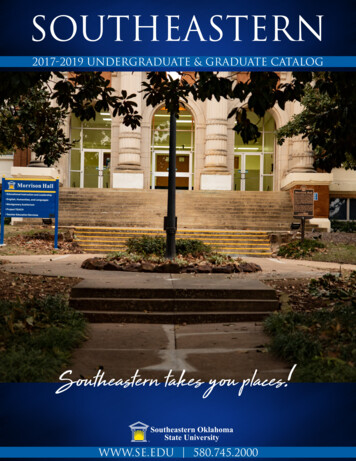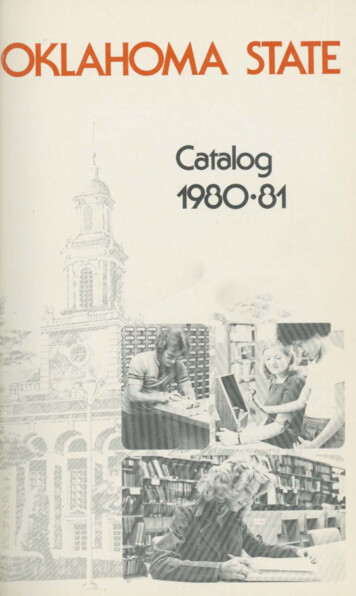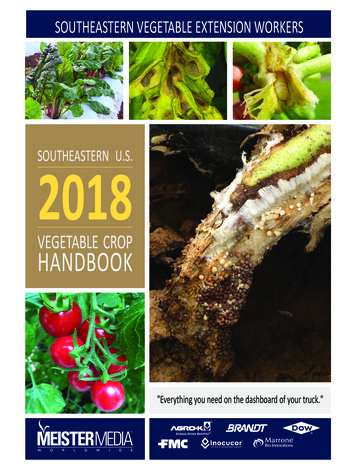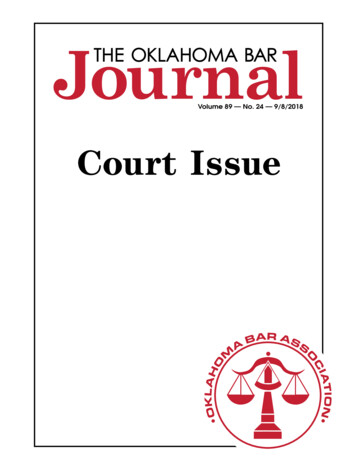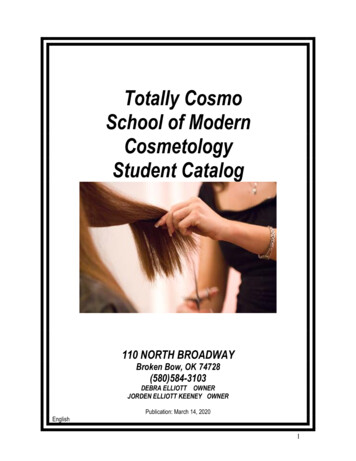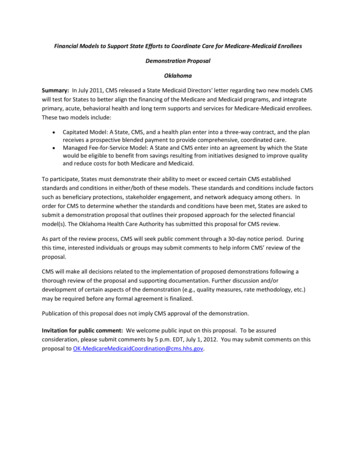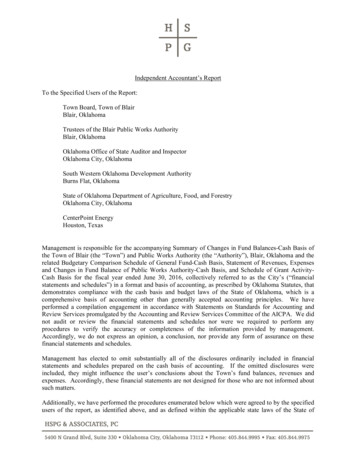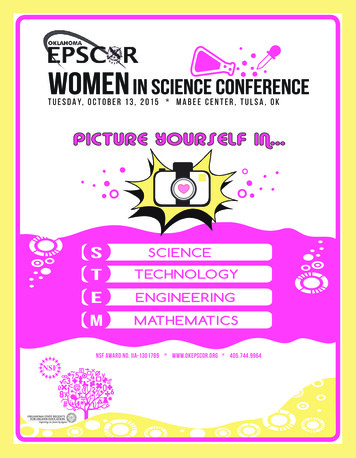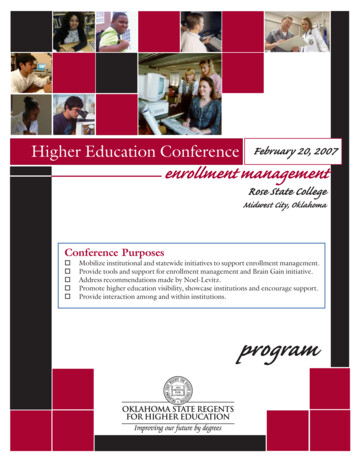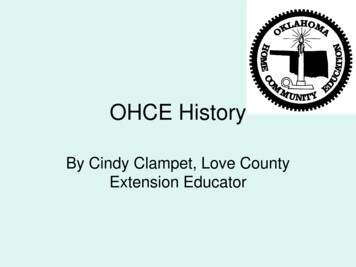
Transcription
OHCE HistoryBy Cindy Clampet, Love CountyExtension Educator
Rural American Women Late 1800searly 1900s, theclubs were notunified, andcalledthemselves bydifferent namesFamily was most importantFormal education was ended earlyTransportation was unreliableWomen married young, sometimes movedfar from their families—lacked a supportgroup Living conditions were primitive whencompared to today’s standards
“Show and Tell Method” The “show and tell method” came about in1903 when the nation’s cotton crop wasthreatened by the boll weevil. The USDA recognized the need of countyagriculture agents to educate farmers, andthe need of home demonstration agents toeducate women in ways to make life betterfor their families
Early Extension In 1905, trains in Louisiana carried homeeconomics teachers from LouisianaPolytechnic Institute to give lectures anddemonstrations on better practices inhomemaking. The first Louisiana homedemonstration agent was employed in1912.
Early Lessons Food preservationMattress makingQuiltingKitchen improvement contestsSewing clothing and household linensGetting involved in kid’s education—providing balanced lunches, andsupporting the 4-H clubs
Extension Partnership In 1862,the Morrill Act was passed by theUS Legislature which granted federal landto each state to establish a college toteach agriculture and mechanical arts,including home economics. (OSU) In 1890, a second Morrill Act added blackpublic colleges and institutions in 16southern states to the land grant system(Langston University)
In 1914, the Extension Service wasformally established in each state toprovide instruction and demonstrations inhome economics and related subjects tothose not affiliated with land-grantinstitutions. Also in 1914, the Smith-Lever Act createdfederal, state, and county funding for theadvancement of agriculture and a divisionof home economics within the USDA
World War I Era (late teens andearly 1920s) Members joined the war effort byincreasing individual food production Making comfort kits for the Red Cross The Great Depression happened soonafter, emphasis was placed on maintainingsafe diets at a minimum cost In 1928, prevention of pelegra receivedspecial attention
Home Extension Reached all Extension Educators traveled all over thecountry, providing research basededucation to homemakers. Some traveledby car, but many traveled by train, horseand buggy. Many spent the night with alocal family, then returned home the nextday. In 1928, there were 18,956 clubswith 388,197 members across the US.
One of the greatest first contributions of homedemonstration agents was to teach canning.Pounds of fruit and vegetables were going towaste and families didn’t know how to preservethem. The agent traveled to a community,conducted a demonstration, spent the night andthen moved on. After a group lesson, eachwoman got to keep the pressure cooker for oneday, then pass it on. During the GreatDepression, there was a “cow killing” because oflack of feed. The art of pressure canningpreserved the meat for meals ahead. July 24, 1935, the Oklahoma StateHome Demonstration Council wasorganized
Club membersbecome community leaders Clubs raised money for pressure cookersfor all to chare, to buy buildings to holdclub meetings, To raise money to modernize the kitchensin their meeting places In 1935, the state clubs organized to forma national organization for extensionhomemakers clubs, but Oklahoma did notvote to join that organization until1944
The 1930s Problems encountered in the 1930s andaddressed by extension educatorsincluded: Health and safety*4-H Family relations*home and Educationcommunity Librariesbeautification The official name was National HomeDemonstration Council
Homemakers had influence County Health Departments wereestablished due to pressure fromhomemakers groups The school lunch program was started byhomemakers preparing hot soup whichwas served in the schools Rural reading programs, traveling libraries,and establishment of community librarieswas started by homemakers groups
Homemakers raised money To finance family income or clubtreasuries, members raised moneythrough sale of home products. Clothing, needlework, rugs, fruitcakes, jellies, jams, were sold “Curb Markets” and organizedcooperatives helped members sell surplusfarm products
Homemakers were resourceful Men’s suits were remodeled into jacketsand skirts for women Soap was made from surplus fats Mattress making helped use up surpluscotton The droughts, dust storms, andgrasshopper plagues wereaddressed at club meetings
The 1940s The Second World War caused a recession feltby all. Reducing home labor was important ashomemakers learned to “Eat it up, wear it out,make it do, or do without.” Rationing of gas and tires reduced membersattending state and national meetings.Clubs promoted the training of at leastone member of each household in firstaid and home nursing, as health carewas in shortage.
Women learned to reupholster furniture,preserve food, repair appliances, and savemoney at every chance. They supported the war effort by knittingsweaters and socks for service men, rollingbandages and sewing for the Red Cross. Victorygardens helped preserve the nation’s foodsupply, collections of rubber, iron, and otherresources was important. Homemakers made life more pleasant byplanning weiner roasts, 4th of July ice creamsocials, costume parties, amateur shows, andpie suppers to please both parents and children.Through the war years, this strengthenedcommunity friendships.
Home Demonstration club members:Sponsored child immunization clinicsMade United Nations flags for schoolTaught each other how to use labor-savingequipment and how to improve andremodel homes (electricity just coming tothe county in the 1940s) Harmon County Council helped pay thesalary for a RN for their county.
In the 1950s NEHC was growing More concern about polio, flies and raw sewage,cleaning up home grounds and communities. Manyroadside parks, road markers, and community signswere the result of club projects Major emphasis was placed on safety as moreAmericans took to the highways. A grant from theAllstate Insurance company provided for safety seminarsannually until 1975. No measure of the lives saved,human suffering reduced or economic value, but NEHCwas credited for the beginning action to get the drunkdriver off the road, and seatbelt legislation.
Civil defense was added to the citizenshipprogram of work, with the “bomb” scare.Members built home shelters and stockedthem with emergency food supplies. First Aid training and home nursingcourses were popular, thousands of treeswere planted by EH clubs, toys were madefor the Salvation Army, women wereencouraged to get annual physicals, someclubs made loans to 4-H members incollege attending medical schools.
With the decreasing number of small familyfarms, families were moving to town, and EHclubs followed. Urban clubs grew, but not fastenough to turn around the decline in totalmembership. The “city” women came to the organization withinterests in tailoring, hat making, upholstering,and interior decorating. In 1959, McCurtain County, OK homemakersbegan work on a homemakers building at thefairgrounds and completed itin two years.
The 1960s 41 state councils belonged to NEHC, with anindividual membership of 867,805. Television was in most homes, society becamemore mobile and more women went to work. EH clubs still a major force behind county fairs,providing food service, but instead of in tents, inmodern kitchens. In 1965, the name of the organization waschanged from State Home DemonstrationCouncil to Oklahoma Extension HomemakersCouncil
EH clubs continued safety programs, and wasdesignated in the top ten of the 152organizations in the US working toward theremoval of hazards to safety. Interest in clean-up campaigns continued. Clubsin 25 states entered Lady Bird Johnson’sbeautification contest. New knowledge about good nutrition showedthat children did not learn as readily without it.This opened up a new opportunity to train aids,who later became nutrition educators under theEFNEP program.
In 1969, the Rubella vaccine wasdeveloped and EH clubs undertook acampaign to convince parents to immunizetheir children. At the national meeting, members wereintroduced to “freeze drying” process forfood, Teflon, miniaturized electronicdevices used in pacemakers, fireproofyarn used in suits for firemen as well ashousehold textiles.
The 1970s EH clubs began to lose more membership numbers asmore women work during the day Families had more of everything, including problemsinfluenced by the outside culture. More awareness ofdrug and alcohol use as they affected highway safetyinfluenced programming. The national board began using the member’s givennames, rather than their husband’s names in theirdirectory. The NEHC bylaws were reviewed and an antidiscrimination clause was added to meet AffirmativeAction regulations Slowly, a few men joined EH clubs, and learningsessions geared toward them were included
As always, EH clubs continued to workextensively with 4-H clubs, county fairs,learning more about management skills,achieving financial stability, improvingleadership skills, and made an effort toincrease recruitment efforts to boostmembership and to include minoritygroups.
The 1980sProgram emphasis included:Playground safety, the farmer’s role in feeding theworld, the work of UNICEF, children’s fairs,preservation of the American art of quilting,nutrition, and financesEH clubs collected eyeglasses which wererepaired and used by college students whotested eyes and fitted glasses for the needy indeveloping countries
A National program, “Healthy Mother,Healthy Babies” was introduced withattention to maternal and newborn healthcare Members learned about forgotten heritageskills, day-care centers and playgroundequipment repair, summer youthprograms, wills and estate planning,nutrition, ovarian cancer research, homehazards, power tool and traffic safety, andseatbelt use
1986 was the 50th anniversary of theNEHC. It was a year to look back over itshistory, build on the past, and look to thefuture . Charter members were honored,the oldest clubs were honored also. Clubswere encouraged to plant marigoldsthroughout the country to commemoratethe golden future on the goldenanniversary. Recognition was awarded to2,867 fifty year clubs
The 1990s NEHC was one of the largest adultvolunteer educational organizations in theUSA with membership of 355,396volunteers in 22,228 organized groups in43 states. NEHC volunteers had taken theleadership in family education acrossAmerica by reaching not only their ownmembership, but by extending knowledgeface to face with millions of non members.
In 1992, the state association changed thename from Oklahoma ExtensionHomemakers Council to OklahomaAssociation for Family and CommunityEducation, and joined the National FCEorganization. In 1996, Oklahoma was # 1 in the nation inmembership. In 2000, Oklahoma members voted todisaffiliate with NFCE and change thename to Oklahoma Home and CommunityEducation, and not be nationally affiliated.
Now, in the 2000s, HCE is still a viableand active part of each of the 77 countiesin Oklahoma, doing important communityimprovement and leadership work in ourtowns, cities, and communities. HCEclubs still work extensively with 4-H, youngparents, county fairs, volunteering atschools, hospitals, fire departments, healthdepartments, and doing all they can toimprove the family lives of others. HCEcontinues to be sponsored by and in apartnership with Oklahoma StateUniversity.
In 1992, the state association changed the name from Oklahoma Extension Homemakers Council to Oklahoma Association for Family and Community Education, and joined the National FCE organization. In 1996, Oklahoma was # 1 in the nation in membership. In 2000, Oklahoma members voted to disaffiliate with NFCE and change the
